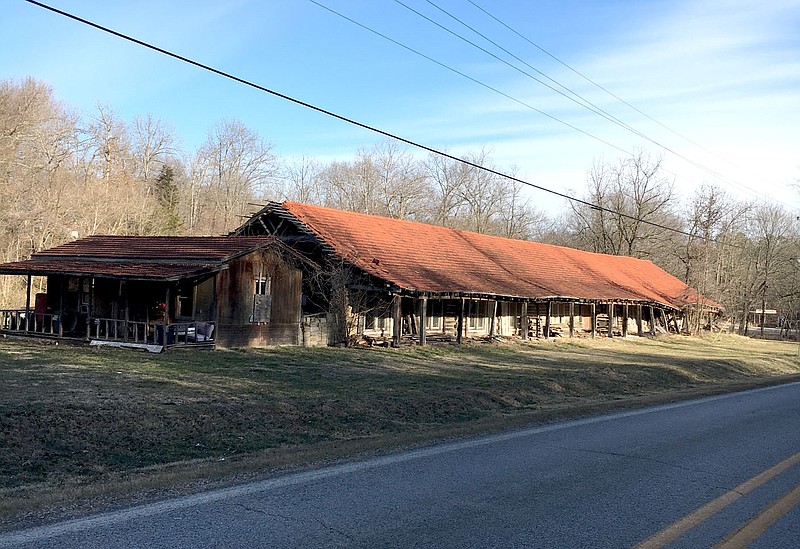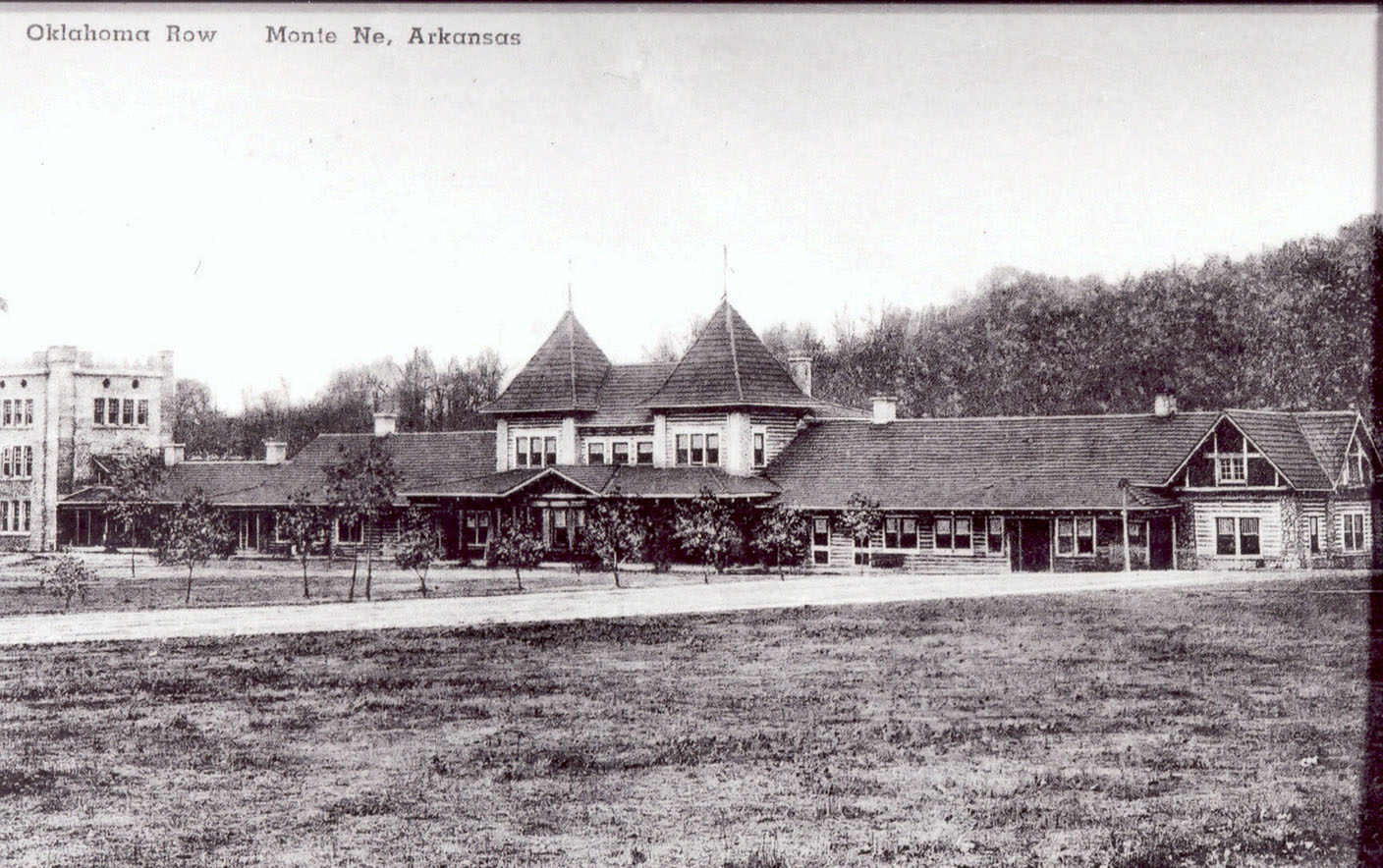The very popular Monte Ne Inn brings many visitors and locals to Monte Ne for its famous food. To get to the restaurant, they pass a large vacant log building with a red tile roof. It is the remains of an old hotel, and not many remember its history.
The story began when an eccentric millionaire named William H. "Coin" Harvey came to Rogers and in 1900 purchased 320 acres of lush valley just outside of Rogers at Silver Springs. He developed an exotic resort and named it Monte Ne.
Harvey dammed the creek produced by Big Spring and numerous other springs flowing through the valley and created a lagoon that extended through the resort and eventually flowed into the White River. By 1902, the first large hotel was completed, the Hotel Monte Ne. He also built the first heated swimming pool in Arkansas, brought the railroad to his resort and built the depot, and brought a genuine gondola and gondolier from Italy for private romantic rides on his man-made lake. There was a bowling alley, pool room, large auditorium, the first golf course in Northwest Arkansas and a newspaper, the Monte Ne Herald.
In April 1904, Harvey organized the Monte Ne Hotel and Cottage Co., the purpose of which was to build five large hotels along the lagoon. He hired a noted architect from St. Louis, A.O. Clarke, to design and supervise the construction of the hotels and also a large bank, the Bank of Monte Ne, and other structures. Missouri Row was the first hotel completed in 1905. It was a log and concrete structure 305 feet long, requiring 8,000 hand-hewn logs and 14,000 cubic yards of concrete. In 1905, the Bank of Monte Ne, a two-story building, 50-by-70 feet and made entirely of poured concrete, was completed.
In August 1909, Harvey, with the financial help of 300 stockholders, opened his third and last luxury hotel at Monte Ne. It was also designed by A.O. Clarke and was the largest log hotel in the world, longer than a football field. It was constructed with 6,000 logs, 40,000 cubic feet of concrete, and a red clay tile roof. Oklahoma Row had 600 linear feet of porches and was distinguished by a three-story concrete tower on the south end overlooking the lake. (This tower and foundation still exist today.) The hotel had 40 rooms, each with a fireplace, indoor bathroom and running water. The original plan by Clarke had identical towers at each end, but the tower on the north end was never built, due to financial problems. In the 1920s, Oklahoma Row became known as the Club House Hotel.
In 1910, from his office in the Oklahoma Row, Harvey conceived the idea of building, mapping and marking a vast network of roads across the United States. This was just two years after Arkansas had issued its first auto license plate. At the time, there were no good roads in the country from town to town, or from state to state, and no maps or road signs to direct travelers. Merchants in the various towns actually wanted roads between towns to be impassable so their customers would not go elsewhere to shop.
Harvey was a visionary and could see that the future of travel was the newly popular automobile, and that meant better roads. He formed the Ozark Trails Association, whose purpose was to promote the routing and construction of a system of roads all across the country. A convention was held at the Oklahoma Row Hotel in 1913. It was said to be the largest gathering of automobiles ever seen in Northwest Arkansas. The movement became very popular in Arkansas and the surrounding states, even as far away as New Mexico. The association under the leadership of Harvey laid out and mapped a unified road system with clearly marked roads throughout the country. The association published a map showing roads, towns and distances. It was said to be the first road map ever published -- the forerunner of the vast network of highways shown on maps today -- and it originated in Monte Ne.
The start of the federal highway system was probably the most significant lasting contribution made by Coin Harvey, even though he created it for the sole purpose of bringing travelers to his resort. He wrote of this project, "my personal interest in the Ozark Trails is that they all lead to Monte Ne."
By the mid-1920s, the resort and hotels were in financial trouble. Coin Harvey was in the midst of building his amphitheater and planning his pyramid. In 1927, he sold the Missouri Row and Oklahoma Row to Dan Evans, who used the hotels for his Ozark Industrial College and School of Theology. The larger rooms of Oklahoma Row were used for classrooms, the south end was used as the girls' dormitory, and the tower was the home of the president. The year 1929 brought the Great Depression, and the school found itself in financial trouble and closed in 1932.
In the 1920s, Iris Armstrong had a private dramatic academy in Little Rock. She wanted to establish a summer camp for girls and young women where they could be given instruction in drama and the arts, and at the same time provide wholesome outdoor experiences in sports such as riding, swimming, canoeing, horseback riding, tennis and others. She sought the advice of Coin Harvey, and of course he suggested the perfect location of 100 acres adjoining his resort at Monte Ne. Joyzelle was an exceptionally fine camp for mostly affluent girls and operated from 1923 until it was acquired by the Corps of Engineers for Beaver Lake in 1962. In 1945, Iris Armstrong acquired the Oklahoma and Missouri Row Hotels and kept them open for several years so parents and visitors could stay close to their children and friends at Joyzelle.
By 1955, Oklahoma Row had been vacant for several years and was badly deteriorated. A Springdale antiques dealer, Dallas Barrack, bought the hotel for $15,000 on Oct. 21, 1955, and renovated it to its former splendor for his Palace Art Gallery. After the rooms were redecorated and filled with antiques, it was said that the hotel surpassed its original beauty. The three-story tower was remodeled into living quarters consisting of five bedrooms and three baths for the managers, Mr. and Mrs. Robert Buhrkuhl, and their five children. (Mrs. Robert Buhrkuhl, Benton County Pioneer, January 1957.) The hotel was condemned for the creation of Beaver Lake in the early 1960s, and Barrack, like many landowners, felt that he was forced to sell the old hotel/art gallery for far less than it was worth.
When Beaver Lake was created in the 1960s, the U.S. Army Corps of Engineers had the tremendous task of removing or leveling all structures that would be underwater or near the water. One of the contractors tasked with this job was J.G. Gladden, who owned heavy equipment suitable for the job. No one wanted to move the old hotel, so he asked the COE if he could have it. They told him to submit a bid, so he put in a very low bid and was awarded the hotel -- but he had to move it. Gladden dismantled it and moved the log and roof sections up the hill on Arkansas 94 just west of the Monte Ne Inn, where it still sits today. He reassembled the structure minus the concrete sections and tower, but developed health problems and was never able to finish the project. It has sat vacant in the same location since 1962.
The three-story tower, foundation and underground rooms still exist on the bank of Beaver Lake. Looking at the historic tower brings back visions of all of the people who vacationed there and looked out over the lake at the gondola as it floated by with happy passengers, while the gondolier sang romantic songs. From the rooms in the tower you could gaze across the lake to the Monte Ne Railroad, as it chugged into the station with a load of eager visitors from all over the country. The tower on the bank of the lake and the remains of the hotel up the hill are all that is left of one of the oldest and most historic structures in the county. Both are deteriorating and probably won't be around much longer.


